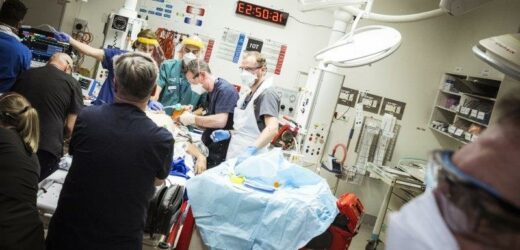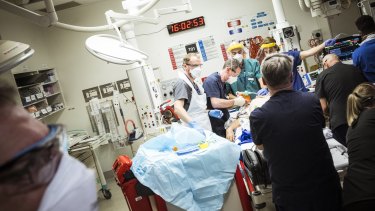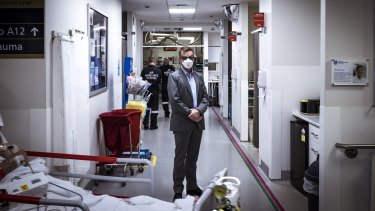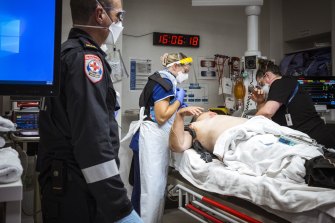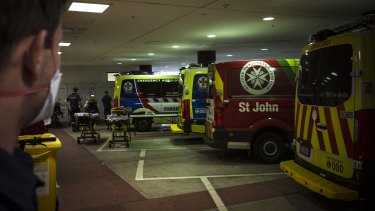Talking points
- The demand on emergency departments in Victorian hospitals has reached a level that doctors and nurses say is the worst they have seen in years.
- The Royal Melbourne Hospital aims to get 90 per cent of ambulances unloaded within 40 minutes, but at times sits about 50 per cent.
- Victoria’s ambulance service was forced to declare a code red for two hours in late March.
A corridor inside the Royal Melbourne Hospital’s emergency department is lined with five people strapped to gurneys.
The hospital’s head of emergency says five minutes is the longest these patients brought in by an ambulance should wait before being transferred to a cubicle.
A man brought into the emergency department under cardiac arrest is worked on at the Royal Melbourne Hospital. Credit:Chris Hopkins
But on Friday afternoon, when The Sunday Age visited the emergency department, the wait is far longer for those in the queue suffering severe stomach aches, chest pains and psychiatric episodes. One patient waits for more than three hours to be seen.
Within two hours, the queue has grown to eight stretchers, with another five walk-in patients also needing to be urgently assessed.
Paramedics who should be out on the road tending to triple-zero calls are instead milling around the corridor; they are required to care for their patients until a bed is made available.
This backlog, known as ambulance ramping, is a sign the emergency ward is in trouble.
The demand on emergency departments in Victorian hospitals has reached a level that doctors and nurses say is the worst they have seen in years, as the negative health impacts of a two-year pandemic — in which GPs stopped seeing patients face to face, elective surgeries were postponed and routine heart and cancer checks were delayed — comes to bite.
People are presenting with more severe and complex disease, while the growth in admissions exceeds the expected 5-10 per cent annual rise, straining hospital resources beyond capacity.
The lifting of lockdown measures and the return to work and school has meant people are back on the roads, resulting in more road accidents, while the wave of alcohol or substance abuse linked to social events adds to the pressure.
Meanwhile, there is a steady flow of COVID-19 admissions. On Saturday, there were 366 COVID-19 patients in Victorian hospitals, but the director of emergency at Royal Melbourne, Mark Putland, believes this is the equivalent of 500-700 Victorian hospital beds, due to the extra resources required in preventing virus transmission.
These factors have combined to create a perfect storm for the state’s emergency medical efforts. Victoria’s ambulance service was forced to declare a code red for two hours in late March due to rising demand and ambulance ramping.
Before the pandemic, Royal Melbourne’s emergency ward at its peak managed to admit 250 patients a day.
Dr Mark Putland, director of emergency medicine at the Royal Melbourne Hospital.Credit:Chris Hopkins
Today, it admits as many as 290 patients, but with depleted resources due to furloughed or burnt-out staff and a healthcare system that has been battered by repeated lockdowns.
Dr Putland watches as the queue of ambulances outside his emergency department grows on Friday.
“This is unfortunately what happens when we can’t unload people straight away,” he says. “There’s just nowhere to put them.”
On a bad day, the number of ambulances ramped at the Royal Melbourne can rise to more than 20 at once — a scenario that was inconceivable before the pandemic.
“We aim to get 90 per cent of our ambulances unloaded within 40 minutes, but at the moment we’re probably sitting at about 50 per cent, so that’s significantly lower than we want,” Dr Putland says.
The clock strikes 4pm and the hospital, which is one of Victoria’s three major trauma services, is hit with a sudden influx of major trauma patients.
There is a cacophony of loud beeping as a gaggle of doctors and nurses work to revive an unconscious man who is under cardiac arrest, with one medic performing CPR.
A motorcycle accident victim who was airlifted to the Royal Melbourne Hospital is treated in the emergency department.Credit:Chris Hopkins
Within about 10 minutes, a motorcycle accident victim is hurried to a neighbouring resuscitation area that is now heaving with medical staff.
These critically ill patients now absorb a huge amount of the ward’s resources — staff, beds and equipment.
Triage nurses pull up colourful charts on their computer screens to scan for spare cubicles.
With hardly any room spare, they are forced to move high-acuity patients into smaller cubicles that lack the appropriate equipment and staff to manage their conditions.
The emergency ward is now almost full, but not everyone in the department should be there. About a dozen people approved for transfer to other wards cannot leave due to a lack of beds or staff in the wards they are meant to go to.
This problem, termed “access block” by medical staff, runs counter to a functioning emergency department, where high patient turnover is key.
Sick people should receive immediate care and then be transferred to a separate ward or discharged, freeing up their bed for the next emergency patient.
One woman in the emergency queue, suffering exacerbated schizophrenia, will be forced to stay in an emergency room for 24 hours before she can be transferred to an inpatient bed at a psychiatric ward because there are no available beds.
Three years ago, this would have happened once a month, according to Dr Putland. Now, hardly a day goes by when his department is not housing several psychiatric patients at a time for 24-hour stints.
It’s not just psychiatric wards that are clogged, Dr Putland explains. Aged care facilities and rehabilitation centres don’t have capacity to take on more people either.
“Community resilience is down and care for chronic issues and mental health is down,” Dr Putland says. “There’s a terrible shortage of beds for mental health patients, particularly in [Melbourne’s] north-west.”
Ambulances “ramping” at the Royal Melbourne Hospital.Credit:Chris Hopkins
It is nearly 7pm. Emergency physician Martin Dutch finished his shift an hour ago, but he is still doing handovers.
He has eaten one toasted sandwich all day, and the last time he drank water was 10am.
“We’re tired,” Dr Dutch says. Signs of exhaustion show up in dark wells around his eyes.
Staff retention has been difficult, with high levels of burnout driving away doctors, but especially nurses, Dr Dutch says.
The impacts of COVID-19 waves are still reverberating in emergency wards, he says. He compares this to advice given ahead of a tsunami.
“The advice says the first wave may not be the biggest wave, but other waves may come, and they may also cause problems,” he says. “This is the tsunami alert for COVID.”
Jacqueline Maley cuts through the noise of the federal election campaign with news, views and expert analysis. Sign up to our Australia Votes 2022 newsletter here.
Most Viewed in National
From our partners
Source: Read Full Article
